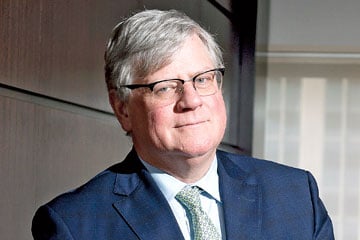
The Law Society of Ontario is looking to reinvigorate its role when it comes to legal aid.

The Law Society of Ontario is looking to reinvigorate its role when it comes to legal aid.
LSO benchers approved a number of recommendations at their January meeting that commit the law society to being more involved in legal aid going forward.
This includes taking a more active role facilitating better communications between the private bar and Legal Aid Ontario, which lawyers say have eroded in recent years.
“The law society looks to play an intermediary role and see if we can help the communications between the two,” says Bencher John Callaghan, chairman of the Legal Aid Working Group, which was convened to look at the issue.
When the law society relinquished control of the administration of legal aid in 1999, the regulator stepped back to allow the implementation of the new system that would be run by Legal Aid Ontario.
Michael Lacy, president of The Criminal Lawyers’ Association, says this led to the law society believing it would not be appropriate to take an active role in the way in which LAO was interacting with lawyers.
“My perception is that this meant that, often, associations like ours were left to fend for ourselves in terms of meetings and discussions with governments and legal aid as the law society feared they would be encroaching upon LAO’s turf,” he says.
Lacy says the report, which CLA supports, recognizes the overlap between the two organizations where LSO can be an important voice in the discussion.
He says that having the law society further facilitate communication should result in the concerns of stakeholder groups taking on even greater importance, as the LSO has a larger voice than individual associations.
He adds that CLA sees the report as a first but very welcome step in the right direction.
The relationship between the private bar and LAO has soured in recent years, as the organization has increasingly hired more staff duty counsel and in-house counsel, much to the dismay of the private bar, who argue they can better serve the public through the certificate system.
Last year, LAO temporarily scaled back certificates in cases where the accused was not facing jail time after posting a $26-million deficit.
At the time, the private bar blamed the deficit on a swelling staff at the organization.
LAO officials said the deficit was largely due to an increase in refugee services in recent years.
LAO also threatened to suspend its refugee services last fall if it did not receive the necessary funding from the federal government, which came through in the end.
The law society is looking to not only build a stronger relationship between it and LAO but also to help improve LAO’s relationship with the private bar.
Callaghan says that LAO officials have said they believe they have been communicating well, but other stakeholders have said communications could improve. He says the law society hopes to provide a neutral forum for stakeholders to make sure they feel like they are being heard.
As part of the approved recommendations, the law society will also look to convene public symposia on legal aid issues, encourage the collection of demographic data on legal aid and champion the need for “robust legal aid” with the federal and provincial governments.
Going forward, the law society’s recommended nominees to the LAO board will include individuals with experience in the legal aid system from the clinic system and the private bar.
The law society will also set up a protocol for the individuals it recommends to the LAO board to ensure communications flow between the two organizations.
Sean Rehaag, an associate professor at Osgoode Hall Law School, says the report includes helpful recommendations about improving stakeholder communications and transparency at LAO, but harder questions remain.
“It is nice to see the law society talking about access to justice for low-income people. At the end of the day, though, the report shies away from important questions,” Rehaag says.
Rehaag, who resigned from being a member of an advisory committee to LAO's board in 2014 because he lost confidence in LAO management, says these questions include why legal professionals dominate the bodies that govern both LAO and the law society, how the organizations could be structured to be more accountable to clients rather than professionals and why law society fees are structured so that junior lawyers doing work paid through legal aid pay the same fee as senior partners on Bay Street.
“While I’m all for improving things at LAO, there’s even more work to be done to transform the law society into an organization that fights against the marginalization of low-income people rather than perpetuating that marginalization,” he says.
Callaghan says the report, however, is just a beginning.
“People have to see the report for what it is. It’s not an end. It’s a start,” he says.
“It’s to get the law society engaged.”
Callaghan adds that it is also important to remember where the different mandates of the law society and LAO differ.
The group did not want to conflate the two, he says.